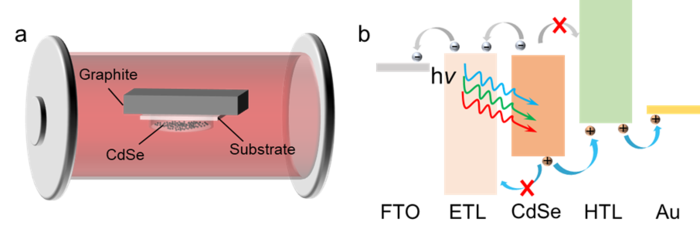Cadmium selenide (CdSe) is an II-VI semiconductor material with a bandgap of around 1.7eV, which makes it ideal for building thin-film solar cells with strong optoelectronic properties, remarkable stability, and low manufacturing cost. Its application in PV devices, however, has been limited to a few research works to date, due to the lack of proper manufacturing processes.
According to a group of scientists from China, rapid thermal evaporation (RTE), which is a process that is commonly used for evaporating and depositing a material on a substrate located within 10mm of the source, could fill this gap and help produce solar cells based on high crystal quality with large grain size.
“One of the technical challenges is how to obtain highly crystallized CdSe films with low defect density,” they explained in the study Rapid thermal evaporation for cadmium selenide thin-film solar cells, published in Higher Education Press. “Furthermore, as an n-type semiconductor, finding a suitable p-type candidate is important to build a high-quality PN junction with CdSe thin film.”
The cell was built with a CdSe thin film with a direct bandgap of 1.72eV that was prepared via chemical bath deposition for 16 minutes on a fluorine-doped tin oxide (SnO2:F, FTO) transparent glass substrate. RTE was used for depositing the CdSe films by evaporating CdSe powder with 99.995% purity. The electron transport layer (ETL) was made with zinc oxide and cadmium sulfide (ZnO/CdS) and the hole transport layer (HTL) with the PEDOT polymer and copper iodide (CuI). Gold contacts with a size of 0.09cm2 were deposited using a resistance evaporation thin-film deposition system.
The scientists produced a solar cell with a thickness of 500nm that achieved a power conversion efficiency of 1.88%, an open-circuit voltage of 0.501V, a short-circuit current of 6.45mA/cm2, and a fill factor of 58.1%.
“This is a preliminary exploration and demonstration of the feasibility of CdSe thin-film solar cells. Further effort is required to focus on solving the problem of carrier transport at the ETL/CdSe interface, to improve short-circuit current, which will enhance the efficiency of CdSe solar cells to a new level”, the scientists concluded, noting that this kind of solar cell may be potentially used as a top subcell in tandem crystalline silicon-based devices.
This content is protected by copyright and may not be reused. If you want to cooperate with us and would like to reuse some of our content, please contact: editors@pv-magazine.com.




3 comments
By submitting this form you agree to pv magazine using your data for the purposes of publishing your comment.
Your personal data will only be disclosed or otherwise transmitted to third parties for the purposes of spam filtering or if this is necessary for technical maintenance of the website. Any other transfer to third parties will not take place unless this is justified on the basis of applicable data protection regulations or if pv magazine is legally obliged to do so.
You may revoke this consent at any time with effect for the future, in which case your personal data will be deleted immediately. Otherwise, your data will be deleted if pv magazine has processed your request or the purpose of data storage is fulfilled.
Further information on data privacy can be found in our Data Protection Policy.